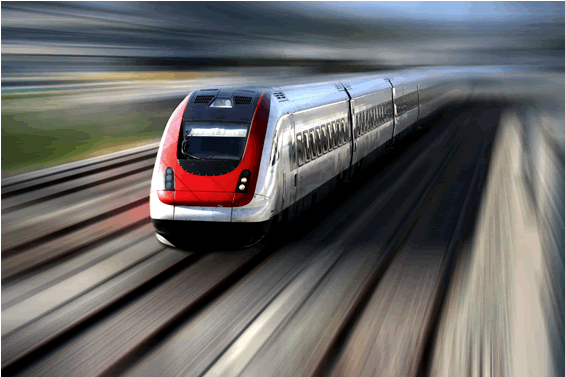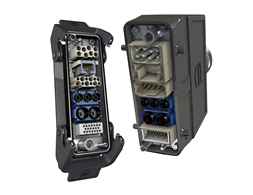Evolving Rail Designs Compete for Space
With new electronic technologies aimed at growing US rail ridership, physical limitations challenge system engineers to adopt greater flexibility in interconnection requirements.

(Photo courtesy of HARTING Inc. of North America)
Designers seeking new opportunities for competitive advantages in railway vehicles are constantly imposing greater demands on electrical and electronic system interconnections: Wi-Fi connectivity helps attract and retain ridership; infotainment screens enhance the rider experience, as well as generate new revenue streams; video cameras in new unit designs (or retrofits in existing rolling stock) bolster security; and the latest safety systems help to minimize risk and liability.
Collectively, however, those enhancements create new pressures to squeeze more functionality from cabling and connectors in an already limited space. And whatever the application or solution, requirements for rugged and reliable operation in the rail environment leave little room for error.
More Functionality, Less Space
According to Bob Laskowski, transportation industry segment manager at HARTING Inc. of North America, one strategy for making more efficient use of space is to aggregate multiple interconnect applications within one compact unit. That can be accomplished through physical connector designs or electronic switching, as required by the demands of the application. A key concern with either approach is withstanding the shock, vibration, and other harsh environment conditions inherent in rail applications.
A Physical Approach
One physical approach for greater space efficiency involves combining multiple discrete connections – power, signal, data, and even optical or pneumatic connections – within a single space-saving modular connector housing.
“For general power connection, I think the modular approach has a lot of benefits in terms of being able to mix and match different current ratings or adding communications signals along with signal power to a connector,” says Laskowski. “It allows you to reduce the amount of connectors being used on a transit vehicle.”

Rectangular connector housings with modular inserts enable designers to integrate a variety of power, signal, data, and other connections in a compact space. (Photo courtesy of HARTING Inc. of North America)
That concept incorporates modular inserts that can be configured within one overall housing to enable the unique connections required by a specific application. Insert options range from millivolt network connections to high-power 600-amp applications, even fiber optic or compressed air lines. Insert and housing options include designs to satisfy shielding requirements as well as harsh environment exposure.
A Switched Approach
A switched approach to space-saving efficiency utilizes the intelligent bus of Ethernet connectivity to manage multiple system or subsystem connections through a single switch. “We’re seeing more functionality being required in areas such as infotainment and security,” Laskowski says. “Plus everything within the railcar is getting ‘smarter.’ Operators want to know more about what happens with the transit car, how the door system is closing, how you can maintain temperature control more closely. All of that means more sensors, more data, more connectivity.”

M12 Ethernet connectors from HARTING use vibration-resistant crimped connections packaged to provide IP65/67 performance with EMC protection in a field-installable design. (Photo courtesy of HARTING Inc. of North America)
With one 80-foot rail car incorporating a couple of miles of cabling, the most practical solution is to let Ethernet switches manage networked connections for a variety of control applications. Those can range from critical systems such as driver consoles and braking control, to environmental lighting and HVAC systems, to conveniences such as in-car displays and infotainment.
Reliability for 10Gb/s Ethernet-based rail applications involves built-in redundancy and fail-safe modes but, at the most fundamental level, reliability comes down to connector performance. “Relative to the shock and vibration in rail cars, RJ45 connectors have inherent limitations that could lead to problems down the road,” says Laskowski. “That is why we worked with our rail customers about a decade ago to develop an M-12 Ethernet connector with crimp-type termination for more robust performance.”
Planning for 2020 Starts Today
Based on unique demands of functionality, buyer preference, operating environment, and physical dimensions of specific rail system facilities, virtually every rail car order becomes a custom design. That makes interconnection versatility all the more critical when you weigh the relatively long planning cycles for rail transit programs – up to three years – against costly repercussions for making changes deeper in the design phase.
Yet, just as Ethernet flexibility has been documented in current rail applications around the globe, so too do continuing developments offer new promise for next-generation rail vehicles currently taking shape on designer drawing boards.
For example, versatile HARTING Ha-VIS pre-Link Ethernet connection technology enables forward-thinking designers to “future-proof” their rail cars, simply by installing eight-wire Ethernet cables now. It delivers robust performance in today’s four-wire Fast Ethernet applications, while creating a cost-effective path to eight-wire Gigabit Ethernet capability down the road.
Author Peter Antoniewicz is a veteran freelance writer who covers high-tech and business-to-business topics for a variety of corporate, agency, and editorial clients. He has written on subjects ranging from embedded computing, electronics, and software to ag-chem, medical imaging, engineered solutions, industrial products, and business services. Email him at [email protected].






